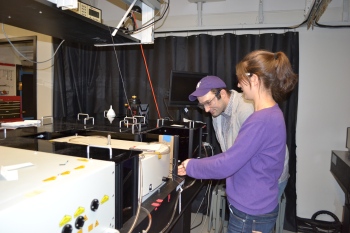With Operations Iraqi Freedom/New Dawn having ended and Enduring Freedom drawing to a close a new push is underway to retrain our returning veterans. The wars have produced 2.5 million veterans and the Center for Sustainable Nanotechnology (CSN) is part of the push to help veterans retool their skillsets for civilian life through participating in the Research Experiences for Veterans program. This is my story of how the CSN is helping me transition to my post-military life.

Over Thanksgiving of 2012 in Okinawa, Japan I had the opportunity to do some soul searching and came to the conclusion that I was ready to move on from the military. While trying to figure out what direction I was going to take my life and what truly fascinated me, I asked myself the fateful question, “what are we made of at the most basic level, and how does it work?” Little did I foresee that two years later that question would lead me to the CSN.
On June 1st 2013 I separated from the service after eight years, serving as the commanding officer of my company until literally the final week. My service had taken me around the globe from South Korea to Kuwait, Germany to Iraq, and finally two and half years in Japan. I was returning home to Evanston, IL to participate in Northwestern University’s pre-health program with a focus on chemistry, to begin pursuing the answer to my question.
Twenty-three days after taking off the uniform I began the summer sequence with no prior knowledge of chemistry, scheduled to cover a year of general chemistry in nine weeks. Under the instruction of the Director of Undergraduate Studies for chemistry, Professor Frederick Northrup, the class proceeded at a grueling pace, often requiring upwards of 12 hours a day of schoolwork, seven days a week.
The transition from soldier to scientist came as somewhat of a shock. While our most junior soldiers had been 18-year-olds, I was now surrounded by people of that age and in many cases they were far ahead of me in the course content, having just finished AP chemistry as juniors or seniors in high school. Transitioning from being an authority figure holding legal powers to having to ask for help with trends in the periodic table was a complete reversal of field. During this time I came in contact with the Geiger group for the first time. Two Geiger group members were TAs for my class (Alicia McGeachy and Hilary Chase) and they stood out for helping students trying to keep up with the breakneck speed of the course.

Northwestern’s chemistry curriculum places a strong emphasis on nanotechnology and each student in the summer class was assigned to write a research review of recent nano innovations. With my proclivity towards medicine I became fascinated with the nano work being done in biological systems. I was particularly interested in work on transporting drugs across the brain blood barrier and the incredibly innovative methods being developed to treat cancer. I knew I had found what I had initially set out for: to learn about what happens at the most basic level of matter.
By chance, one weekday evening during a study break stroll on campus, I came upon a flier for the CSN Research Opportunities for Veterans (REV) Program. With my newfound interest in nanotechnology it was truly a ‘Eureka!’ moment. The REV program recognizes that veterans are underrepresented in America’s science and technology sectors, and works to incorporate them in sustainable nanotechnology research. Intrinsic with this kind of research is exposure to tools and techniques that go far beyond those contained in any undergraduate chemistry curriculum, truly adding an extra layer of depth to laboratory skills.
Shortly after finding the flier I met with Dr. Geiger, who described the CSN research being conducted in his lab. The specific question they are addressing is “how do nanomaterials interact with lipid bilayers?” I quickly understood the far ranging possibilities of this research, as all living organism have lipid bilayers; I was sold on the project.
In September I began attending group meetings to gain exposure to the way the group functions, the kind of work being done, and to ease into the team while adjusting to a normal quarter’s course load. From the outset it was obvious they work together and help each other out. Organizationally, the group is dedicated to developing the laboratory skills of each member, setting standard expectations for mastery of the tools and techniques they use. This is very reminiscent of the military, where each Soldier was expected to be an expert on their tools, whether it be rifles, helicopters, or network routers.
Each week a group member is given the opportunity to present their work from the lab, which is a great chance for the team to put their heads together to help one another out. In a lot of ways, this environment demonstrates the values we tried to instill in the force: teamwork, watching out for your buddy, and dedication to excellence in all activities. The CSN and the Geiger group have demonstrated themselves as a nurturing environment for aspiring scientists, and I look forward to continuing my work with them in the future , as I continue to distance myself from the formation and become warmly acquainted with the lab bench.

Interested in reading more about the CSN’s REV program? Check out the program website or REV student Patrick Sherrill’s blog post about nanoparticles in prosthetics and bionics.
